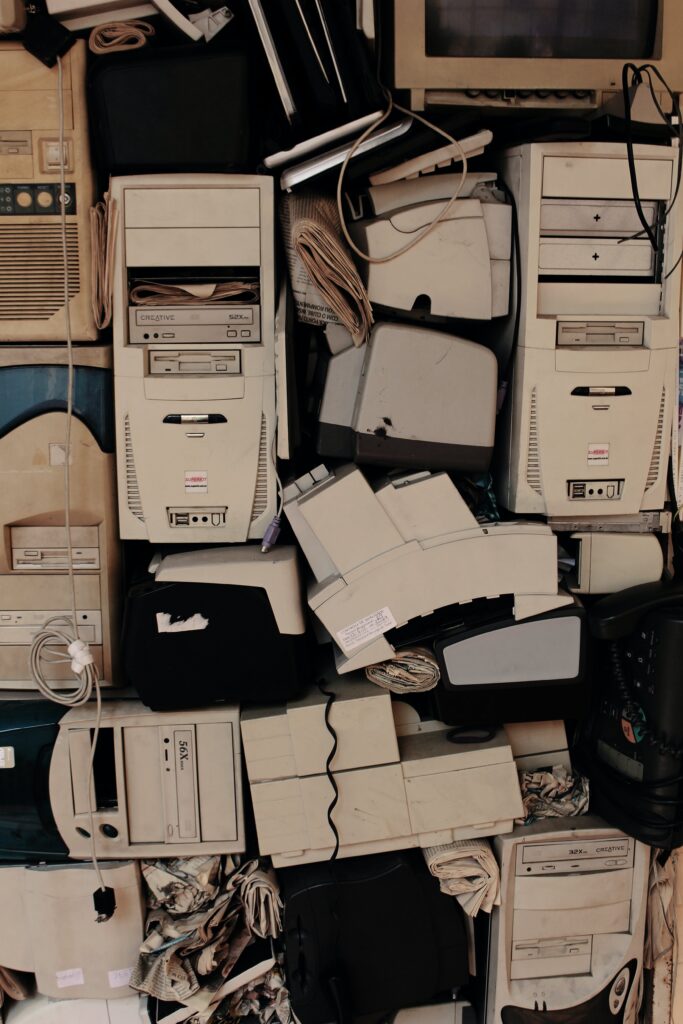Discovery of Computers


What is a Computer?
A computer is a sophisticated electronic device designed to receive, store, manipulate, and output data. By executing a sequence of programmed instructions, it performs complex calculations and logical operations, catering to user-defined tasks efficiently.
Early Computing Devices
Before the advent of computers, humanity relied on primitive tools like sticks, stones, and bones for counting purposes. As human knowledge expanded, technology evolved, leading to the creation of various early computing devices. Let’s explore a few of these significant milestones:
Abacus
Around 4000 years ago, the Chinese invented the abacus, a wooden frame with metal rods and beads. Operators manipulated these beads following specific rules to perform arithmetic calculations.
Napier’s Bones
John Napier developed Napier’s Bones, a manual calculating tool comprising nine separate ivory strips marked with numerals. It was among the earliest devices to use the decimal point system for multiplication and division.
Pascaline
In 1642, Biaise Pascal, a French mathematician, invented the Pascaline, considered the first mechanical calculator. This wooden box incorporated gears and wheels to perform arithmetic operations.
Stepped Reckoner or Leibniz Wheel
Gottfried Wilhelm Leibniz, a German mathematician, enhanced Pascal’s invention, creating the stepped reckoner. This digital mechanical calculator utilized fluted drums instead of gears for computation.
Difference Engine
Charles Babbage developed the Difference Engine in the early 1820s. This steam-powered mechanical computer could perform fundamental calculations and was used for generating numerical tables like logarithms.
Analytical Engine
Also designed by Charles Babbage in 1830, the Analytical Engine was a mechanical computer that processed data through punch cards. It had the capability to solve diverse mathematical problems and store data in an indefinite memory.
Tabulating Machine
In 1890, American statistician Herman Hollerith invented the tabulating machine, a punch card-based mechanical tabulator used for computing statistics and organizing data. His company later became IBM in 1924.
Differential Analyzer
Vannevar Bush introduced the Differential Analyzer in 1930, marking the advent of the first electrical computer. This machine, composed of vacuum tubes, executed calculations by switching electrical impulses and could perform 25 calculations within minutes.
Mark I
Conceived by Howard Aiken in 1937, the Mark I computer aimed to handle extensive calculations involving vast numbers. Constructed in 1944 through collaboration between IBM and Harvard, this machine was a significant leap in computing capabilities.
History of Computers Generation
The term ‘computer’ holds a fascinating etymology. Initially employed in the 16th century, it referred to an individual responsible for computations or calculations. This usage persisted as a noun until the 20th century, often describing individuals, primarily women, hired specifically to perform various forms of calculations and computations.
Toward the latter part of the 19th century, the term expanded to encompass machines designed for performing calculations. In contemporary language, ‘computer’ typically denotes programmable digital devices powered by electricity.
Early History of Computer
Through the course of human history, calculating devices have been integral. Among the earliest, the abacus stands out prominently. However, the real leap forward arrived in 1822 with Charles Babbage, often heralded as the father of computers, initiating the development of the first mechanical computer. By 1833, his groundbreaking Analytical Engine emerged, a pioneering general-purpose computer that featured an Arithmetic Logic Unit (ALU), fundamental flow chart principles, and the concept of integrated memory.
A monumental shift occurred in computer history over a century later with the advent of the ENIAC, the inaugural electronic general-purpose computer. Conceived by John W. Mauchly and J. Presper Eckert, the ENIAC, denoting Electronic Numerical Integrator and Computer, marked a significant technological stride.
Subsequent advancements saw technology rapidly progress, leading to smaller computers with enhanced processing capabilities. The debut of the first laptop in 1981, introduced by Adam Osborne and EPSON, epitomized this evolution, signifying a remarkable milestone in computing history.
Generations of Computers
1st Generation (1940-1955)
During this era, computers utilized machine language and relied on vacuum tubes for circuitry. Memory was facilitated by magnetic drums. These machines were large, complex, and costly, primarily operating via batch systems and punch cards. Notable examples include ENIAC, UNIVAC-1, and EDVAC.
2nd Generation (1957-1963)
The second generation saw a shift from vacuum tubes to transistors, enhancing speed, size, and energy efficiency. Assembly languages like COBOL and FORTRAN emerged, marking a transition from binary coding. Prominent computers of this era include IBM 1620, IBM 7094, and CDC 1604.
3rd Generation (1964-1971)
Integrated circuits (ICs) characterized this period, harnessing numerous transistors on a single chip, boosting computing power while reducing costs. High-level languages such as FORTRAN-II to IV, COBOL, and PASCAL PL/1 were prominent. IBM-360 series and Honeywell-6000 series exemplified these advancements.
4th Generation (1971-1980)
The advent of microprocessors defined the fourth generation. Computers like the STAR 1000, PDP 11, and CRAY series employed languages like C, C++, and Java. Notably, this era witnessed the production of computers for home use, including the Apple II.
5th Generation (Since 1980)
Currently ongoing, the fifth generation of computers is marked by the integration of artificial intelligence. Parallel processing and superconductors have facilitated this leap, promising extensive future potential. ULSI technology drives these sophisticated computers, employing languages such as C, C++, Java, and .Net. Examples include various IBM models, Pentium processors, and diverse computing devices like Desktops, Laptops, Notebooks, and Ultrabook’s.
Brief History of Computers
Throughout history, the journey of computing was fraught with challenges that pioneers tirelessly navigated to unleash the true potential of these machines. Here are key milestones in the evolution of computing:
19th Century
1801: Joseph Marie Jacquard devised a loom utilizing punched wooden cards for automated cloth weaving.
1822: Charles Babbage, a mathematician, conceptualized the steam-powered calculating machine, the “Difference Engine,” laying the foundation for computing.
1848: Ada Lovelace wrote the first computer program, detailing the computation of Bernoulli numbers using Babbage’s machine.
1890: Herman Hollerith pioneered punch card techniques for calculating the U.S. census, establishing the foundation for what would become IBM.
Early 20th Century
1930: Vannevar Bush invented the Differential Analyzer, a large-scale automatic mechanical computer.
1936: Alan Turing envisioned the universal Turing machine, capable of computing anything computable.
1939: Hewlett-Packard was founded in Palo Alto, California.
1941: Konrad Zuse completed the Z3, the world’s first digital computer, though it was destroyed during World War II.
1941: J.V. Atanasoff and Clifford Berry developed a computer capable of solving equations and storing data in primary memory.
1945: John Mauchly and J. Presper Eckert created ENIAC, the Electronic Numerical Integrator and Computer, capable of solving a wide range of numerical problems.
1946: UNIVAC I, the first U.S. general-purpose electronic digital computer, was designed.
1949: EDSAC, the “first practical stored-program computer,” was developed at the University of Cambridge.
1950s-1970s
1953: Grace Hopper developed COBOL, a business-oriented programming language.
1954: John Backus and team created FORTRAN, a formula translation programming language, while IBM introduced the IBM 650.
1958: The integrated circuit (computer chip) was invented by Jack Kirby and Robert Noyce.
1960s-1970s: Milestones included innovations like Ethernet, DRAM chips, the floppy disk, laser printers, and personal computers (Altair, IBM 5100, and TRS-80).
Late 20th Century
1980s-1990s: The era saw the launch of GUIs, operating systems (UNIX, Windows), programming languages (C++, HTML), and significant advancements in hardware.
21st Century
2000 – The USB flash drive made its debut, offering faster speeds and increased storage compared to other data storage options.
2001 – Apple introduced Mac OS X, later named macOS, as the successor to its traditional Mac Operating System.
2003 – AMD launched the Athlon 64, the first 64-bit CPU designed for consumer computers.
2004 – Facebook emerged as a social networking website, marking the beginning of its global impact.
2005 – Google acquired Android, an open-source mobile phone OS based on Linux.
2006 – Apple released the MacBook Pro, the company’s inaugural dual-core, Intel-based mobile computer.
Amazon Web Services, including Amazon Elastic Cloud 2 (EC2) and Amazon Simple Storage Service (S3), were also launched.
2007 – Apple launched the first iPhone, revolutionizing mobile computing. Amazon introduced the Kindle, a pioneering electronic reading system.
2009 – Microsoft rolled out Windows 7, a highly acclaimed operating system.
2011 – Google unveiled the Chromebook, running on Google Chrome OS, providing a cloud-centric approach to computing.
2014 – The University of Michigan developed the Micro Mote (M3), recognized as the world’s smallest computer due to its miniature size.
2015 – Apple introduced the Apple Watch, expanding computer functionalities into wearable technology. Microsoft released Windows 10.
2016 – The world witnessed the creation of the first reprogrammable quantum computer, representing a significant leap in quantum computing technology.
Types of Computers
Analog Computers
Analog computers utilize components like gears and levers without electrical elements. Their advantage lies in the straightforward design and construction tailored to address specific problems efficiently.
Digital Computers
Digital systems represent information in discrete form, typically using sequences of 0s and 1s (binary digits or bits). These computers process diverse information within seconds and are categorized into various types:
Mainframe Computers
Traditionally utilized by large enterprises for critical tasks such as extensive data processing, mainframes are known for their significant storage, rapid components, and robust computational capabilities. Originally managed by specialized systems programmers, these machines are now often referred to as servers.
Supercomputers
The pinnacle of computational power, supercomputers are colossal systems built for solving intricate scientific and industrial problems. They excel in fields like quantum mechanics, weather forecasting, molecular modeling, and nuclear fusion research due to their unparalleled processing capabilities.
Minicomputers
Smaller yet possessing many features of larger computers, minicomputers were affordable and often dedicated to specific tasks within an organization or shared by a small group, typically found in a single department.
Microcomputers
These small-scale computers are built on microprocessor integrated circuits (chips) and commonly known as personal computers (PCs). They include a microprocessor, program memory, data memory, and I/O system, catering to individual or small group use.
Embedded Processors
These compact computers control electrical and mechanical processes using basic microprocessors. They’re simpler in design, have limited processing and I/O capabilities, and require minimal power. Embedded processors, split into ordinary microprocessors and microcontrollers, are used in systems not requiring the computational prowess of traditional devices like desktops or laptops.








